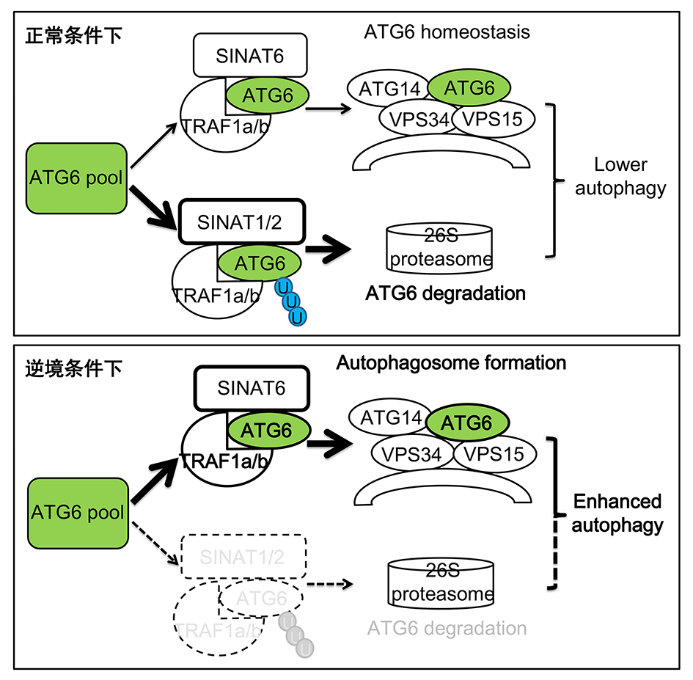Shi Xiao’s research group made new progress in the field of regulation mechanism of plant autophagy
Source: School of Life Sciences
Written by: School of Life Sciences
Edited by: Wang Dongmei
On March 28, 2017, a research article entitled “The TRAF-Family Proteins Regulate Autophagy Dynamics by Modulating AUTOPHAGY PROTEIN6 Stability in Arabidopsis” was published online in The Plant Cell, one of the top journals in plant field (impact factor 10.529). This study led by Prof. Shi Xiao from School of Life Sciences at Sun Yat-sen University unraveled the importance of regulation of protein ubiquitination in the dynamics of plants autophagy. The Plant Cell emphatically recommended for the current article, and published the relevant comment article: "The Family Chores: TRAF font-family Proteins Help Recycle Cellular Rubbish by Regulating Autophagy Dynamics".
As the protective mechanism in plant response to stress, the scientists knew little about the regulation mechanism of plant autophagy. The team of Prof. Shi Xiao screened two TRAF domain containing proteins named TRAF1a and TRAF1b translocated from the cytoplasm to the autophagosome-related structures under starvation conditions by fused them to GFP for transient expression in Arabidopsis protoplasts and confocal laser scanning microscopy analysis. Plants lacking of TRAF1a and TRAF1b altered sensitivity to biotic and abiotic stress including hypoxic stress, indicating that TRAF1a and TRAF1b invoveled in autophagy via the posttranslational modification of the autophagy related protein. Genetic and biochemical evidence showed that TRAF1a and TRAF1b as molecular adapters, recruit different E3 ligase SINAT1 and SINAT2 to ubiquitinate and degrade of ATG6 under normal condition or SINAT6 to maintain ATG6 homeostasis by competitively associating with ATG6 under starvation condition to ragulate the dynamic of autophagy (Figure 1). This finding with important scientific significance provides a new research direction of regulation mechanism for further research on plant autophagy.

This work was supported by the Program for New Century Excellent Talents in University and National Natural Science Foundation of China. Prof. Shi Xiao is the corresponding author, Ph.D. students Hua Qi, Fannv Xia and Dr. Lijuan Xie are co-first authors. Prof. Liwen Jiang from the Chinese University of Hong Kong, Prof. Qi Xie from Chinese Academy of Sciences and Prof. Faqiang Li from South China Agricultural University are co-authors, who provide necessary technical support for this work.
Since Prof. Shi Xiao served in the School of Life Sciences from 2011, Prof. Shi Xiao and faculty members have made substantial achievements in international publications. For the past five years, Prof. Shi Xiao has published 6 academic papers in first-class international biology journals as corresponding author, 8 scientific papers as co-first author or co-author. One of the published papers was selected as highly cited papers and highlighted paper of ESI, two of them were selected as expanded highly cited papers of ESI.
Link to this paper: http://www.plantcell.org/content/early/2017/03/28/tpc.17.00056.abstract
